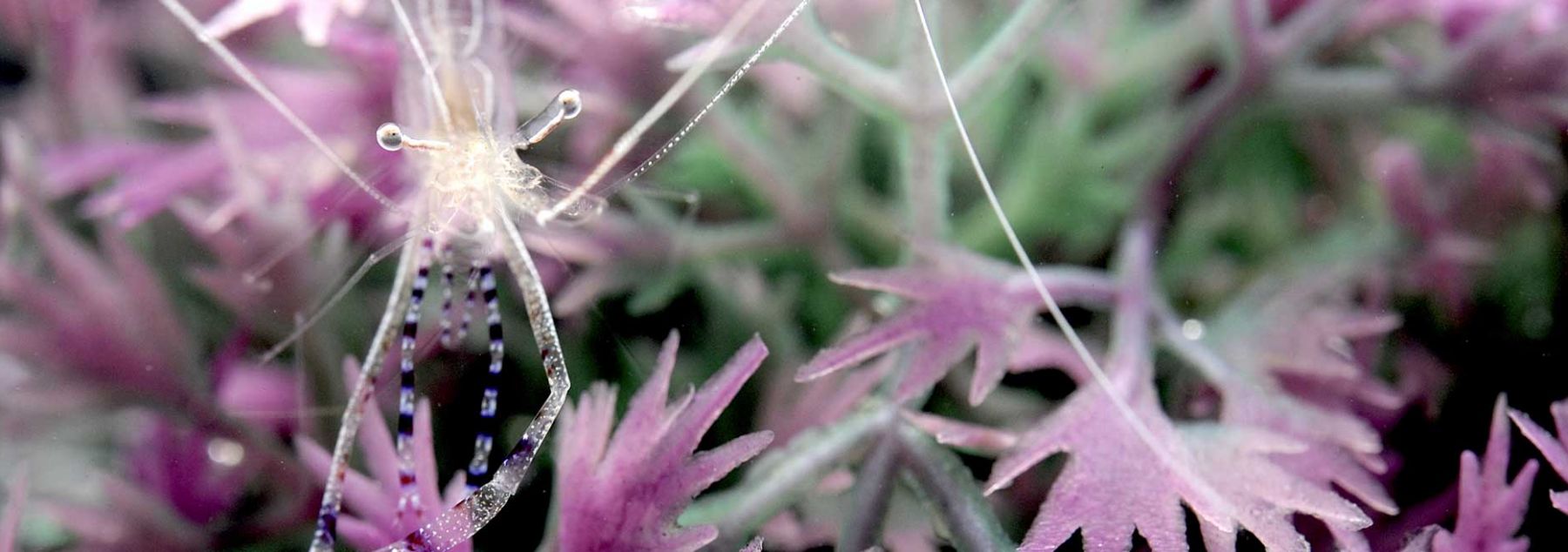Animal visual capabilities differ significantly from our own, so in studies of visual signals and visually guided behaviors, we must account for the appropriate receiver’s visual capabilities. Much of our research applies measures of receiver visual capabilities to studies of signaling. We focus in particular on interspecific interactions, in which the two parties may have very different visual capabilities. Most of our work in this area involves cleaning interactions, an interspecies interaction in which small “cleaner” organisms remove and usually consume material from a larger “client.” In the case of cleaner shrimp, our primary study system, many clients are large fish that have the potential to be predators; despite this, cleaners are rarely consumed. Our research in this area focuses on asking such questions as:
- How do partners in interspecies interactions perceive and recognize one another? How do cleaners and clients use signals to mediate cleaning interactions?
- How do sensory capabilities and signals co-evolve? How have client fish viewers placed selection on cleaner shrimp signals?
- How do cleaning interactions (and interspecies signaling interactions more broadly) arise and remain stable over time? What information about cleaners do clients glean from signals, and how does that information stay honest and reliable?
Areas of Interest
- Describing cleaning and signaling behavior across cleaner shrimp species
- Incorporating phylogenies to understand the evolution of cleaning and signaling behaviors
- Using measures of client fish vision to explore how cleaner signals have evolved in relation to client fish sensory capability
- Studying the information content of cleaner and client signals, understanding how signal information relates to signal form, and determining the mechanism by which cleaner signals remain "honest" or reliable
Relevant Publications
EM Caves. The behavioural ecology of marine cleaning mutualisms. 2021. Biological Reviews. doi: 10.1111/brv.12770
EM Caves, T Dixit, JFR Colebrook-Robjent, L Hamusikili, M Stevens, R Thorogood, and CN Spottiswoode. Hosts elevate either within-clutch consistency or between-clutch distinctiveness of egg phenotypes in defence against brood parasites. 2021. Proceedings of the Royal Society B. 288: 20210326. doi.org/10.1098/rspb.2021.0326
EM Caves and S Johnsen. 2021. The sensory impacts of climate change: bathymetric shifts and visually-mediated interactions in aquatic species. Proceedings of the Royal Society B. 288: 20210396. doi.org/10.1098/rspb.2021.0396. Covered by: weather.com, Energy & Environment News
EM Caves, PA Green, MN Zipple, D Bharath#, S Peters, S Johnsen, and S Nowicki. 2021. Comparison of categorical color perception in two Estrildid finches. The American Naturalist: 197: 190-202.
EM Caves*, C Chen*, and S Johnsen. 2019. The cleaner shrimp Lysmata amboinensis adjusts its behavior toward predatory versus non-predatory clients. Biology Letters: 15, 20190534
EM Caves, PA Green, and S Johnsen. 2018. Mutual visual signalling between the cleaner shrimp Ancylomenes pedersoni and its client fish. Proceedings of the Royal Society B 285: 20180800
EM Caves, M Stevens, and CN Spottiswoode. 2017. Does coevolution with a shared parasite drive hosts to partition their defences among species? Proceedings of the Royal Society B. 284: 20170272
EM Caves, TM Frank, and S Johnsen. 2016. Spectral sensitivity, spatial resolution, and temporal resolution and their implications for conspecific signalling in cleaner shrimp. Journal of Experimental Biology 219: 597-608.
EM Caves, M Stevens, E Iverson, and CN Spottiswoode. 2015. Hosts of brood parasites have evolved egg visual signatures with elevated information content. Proceedings of the Royal Society B 282: 20150598.
